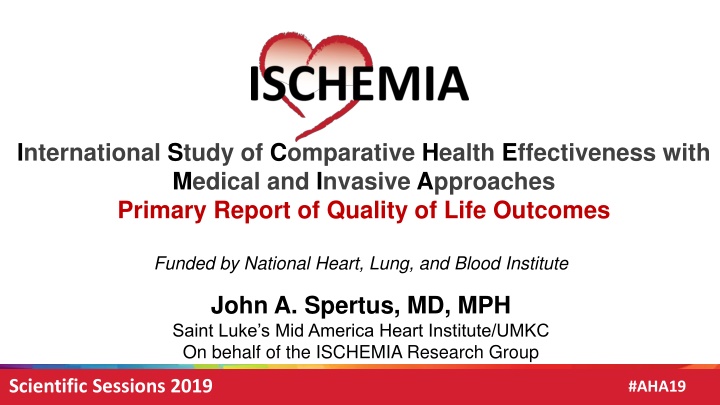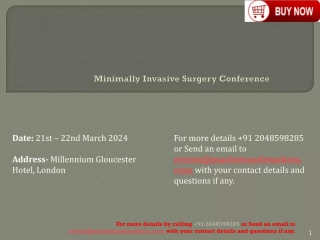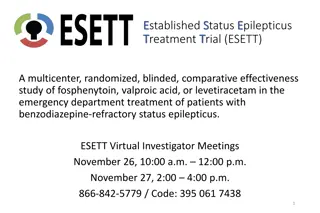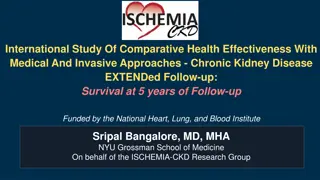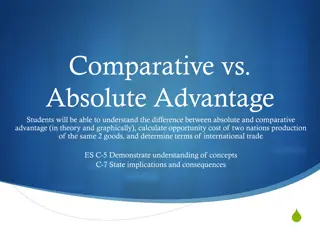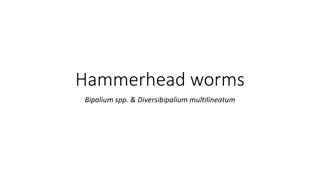Comparative Health Effectiveness Study: Quality of Life Outcomes with Medical and Invasive Approaches
This primary report funded by the National Heart, Lung, and Blood Institute presents the International Study of Comparative Health Effectiveness with Medical and Invasive Approaches. The research evaluates whether an invasive strategy improves health status in stable patients with moderate ischemia, focusing on symptoms, function, and quality of life. The study design involves a comparison of invasive strategy with optimal medical therapy (OMT) against conservative OMT alone, with Seattle Angina Questionnaire assessments at various time points. Statistical methods include mixed-effect proportional odds models and Bayesian analysis to capture treatment effects. The study aims to provide insights into improving quality of life outcomes for patients with ischemia.
Download Presentation

Please find below an Image/Link to download the presentation.
The content on the website is provided AS IS for your information and personal use only. It may not be sold, licensed, or shared on other websites without obtaining consent from the author.If you encounter any issues during the download, it is possible that the publisher has removed the file from their server.
You are allowed to download the files provided on this website for personal or commercial use, subject to the condition that they are used lawfully. All files are the property of their respective owners.
The content on the website is provided AS IS for your information and personal use only. It may not be sold, licensed, or shared on other websites without obtaining consent from the author.
E N D
Presentation Transcript
International Study of Comparative Health Effectiveness with Medical and Invasive Approaches Primary Report of Quality of Life Outcomes Funded by National Heart, Lung, and Blood Institute John A. Spertus, MD, MPH Saint Luke s Mid America Heart Institute/UMKC *Abbreviated Title On behalf of the ISCHEMIA Research Group Scientific Sessions 2019 #AHA19
ISCHEMIA QoL Research Question ISCHEMIA QoL Research Question In a stable patient with at least moderate ischemia, does an invasive strategy improve patients health status (their symptoms, function and quality of life)? ScientificSessions.org #AHA19
Study Design Study Design Stable Patient Moderate or severe ischemia (determined by site; read by core lab) INVASIVE Strategy + OMT 1.5m 3m 6m 12m 18m 24m 30m 36m R CONSERVATIVE OMT alone (Cath if needed) Brief QoL Assessments Brief QoL Assessment Brief QoL Assessment: Seattle Angina Questionnaire 7 Angina Frequency Quality of Life Physical Limitations Completion Rates 94% 93% 92% ** Con: 91% Inv: 88% 88% 89% 93% 92% 92% 90% 91% 91% 90% 89% 88% ** SAQ Summary Score* *Primary QoL Outcome **Secondary QoL Outcome ScientificSessions.org #AHA19
Interpreting and Stratifying SAQ Scores Interpreting and Stratifying SAQ Scores SAQ Angina Frequency Scale: Over the past 4 weeks, how often have you had angina? 4X/day 1-3X/day 1-2X/week <1X/week Not at All 3X/week 0 20 40 Weekly 60 80 100 Daily Monthly None Daily/Weekly ScientificSessions.org #AHA19
Statistical Methods Statistical Methods Simple descriptive statistics of observed mean scores Mixed-effect proportional odds models for all QOL scales Treatment effect = Odds ratio for QOL X, at each time point Results transformed to individual SAQ scales Bayesian methods used for all models to directly estimate probability of treatment effect with posterior means and 95% posterior density intervals Analyses performed for all patients and stratified by baseline angina e.g. daily/weekly vs. several times per month vs. no angina ScientificSessions.org #AHA19
5,179 Randomized Patient Flow Patient Flow 2,588 Invasive 2,591 Conservative 239 improper form completion 242 improper form completion 2,352 Eligible for QOL Analyses 2,346 Eligible for QOL Analyses 29 no baseline assessment 22 no follow-up assessments 17 no baseline assessment 13 no follow-up assessments 2,295 Included in Analyses of Treatment Effect 2,322 Included in Analyses of Treatment Effect ScientificSessions.org #AHA19
Baseline Health Status Baseline Health Status Scale Invasive Conservative SAQ Summary Score SAQ Quality of Life Score 73.3 19 60.9 27 74.8 19 62.7 26 SAQ Angina Frequency Score 80.8 20 82.1 19 Daily/Weekly Angina Several Times per Month 21.6% 44.1% 19.0% 44.5% No Angina 34.3% 36.6% ScientificSessions.org #AHA19
Description of Observed Data Description of Observed Data SAQ Summary Score ScientificSessions.org #AHA19
Description of Observed Data Description of Observed Data SAQ Angina Frequency SAQ Quality of Life ScientificSessions.org #AHA19
Improvement in SAQ Summary Score at 12 Months Improvement in SAQ Summary Score at 12 Months ScientificSessions.org #AHA19
Improvement in SAQ Summary Score at 12 Months Improvement in SAQ Summary Score at 12 Months ScientificSessions.org #AHA19
Primary Outcome: Benefit of Invasive Rx on SAQ Primary Outcome: Benefit of Invasive Rx on SAQ Summary Score Summary Score Typical Patient in ISCHEMIA Posterior Mean = 4.1 (3.2, 5.0)* Posterior Mean = 4.2 (3.3, 5.1) * Posterior Mean = 2.9 (2.2, 3.7)* Favors Conservative Favors Invasive Favors Conservative Favors Invasive Favors Conservative Favors Invasive *95% Highest Posterior Density Interval ScientificSessions.org #AHA19
Primary Outcome: Benefit of Invasive Rx on SAQ Primary Outcome: Benefit of Invasive Rx on SAQ Summary Score Summary Score Typical Patient with Daily to Weekly Angina Posterior Mean = 8.5 (5.8, 11.1)* Posterior Mean = 7.3 (4.8, 9.9)* Posterior Mean = 5.3 (3.4, 7.5)* Favors Conservative Favors Invasive Favors Conservative Favors Invasive Favors Conservative Favors Invasive *95% Highest Posterior Density Interval ScientificSessions.org #AHA19
Primary Outcome: Benefit of Invasive Rx on SAQ Primary Outcome: Benefit of Invasive Rx on SAQ Summary Score Summary Score Typical Patient with at least Monthly Angina Posterior Mean = 5.5 (4.3, 6.9)* Posterior Mean = 4.8 (3.4, 6.1)* Posterior Mean = 3.1 (2.0, 4.2)* Favors Conservative Favors Invasive Favors Conservative Favors Invasive Favors Conservative Favors Invasive *95% Highest Posterior Density Interval ScientificSessions.org #AHA19
Primary Outcome: Benefit of Invasive Rx on SAQ Primary Outcome: Benefit of Invasive Rx on SAQ Summary Score Summary Score Typical Patient with No Angina Posterior Mean = 0.1 (-1.2, 1.4)* Posterior Mean = 1.7 (0.4, 2.9)* Posterior Mean = 1.2 (0.2, 2.2)* Favors Conservative Favors Invasive Favors Conservative Favors Invasive Favors Conservative Favors Invasive *95% Highest Posterior Density Interval ScientificSessions.org #AHA19
Probability of No Angina by Baseline Angina Frequency Probability of No Angina by Baseline Angina Frequency No Difference 45% NNT = ~3 15% Daily Weekly Monthly None n=8 8 67 30 172 140 509 500 850 693 1635 ScientificSessions.org #AHA19
Limitations Limitations Missing SAQ data, although small (<10%) Skewed enrollment towards less symptomatic patients The larger effects in more symptomatic still clearly assessable No sham group Nonetheless, angina-free benefits comparable with that seen in ORBITA ScientificSessions.org #AHA19
Conclusions Conclusions Patients with stable CAD and moderate to severe ischemia had significant, durable improvements in angina control and quality of life with an invasive strategy if they had angina (daily/weekly or monthly) In patients without angina, an invasive strategy led to minimal symptom or quality of life benefits, as compared with a conservative strategy In patients with angina, shared decision-making should occur to align treatment with patients goals and preferences ScientificSessions.org #AHA19
Thank you. Thank you . Quality of Life Core Lab: Philip Jones, Dan Mark, Khaula Baloch, Lisa Hatch ISCHEMIA Trial Chair & Co-Chair: Judith Hochman, David Maron ISCHEMIA Analytic Center and DSMB: Sean O Brien, Frank Harrell ISCHEMIA Site PIs and Data Coordinators The Patients volunteering to participate in ISCHEMIA ScientificSessions.org #AHA19
Backup Slides Backup Slides ScientificSessions.org #AHA19
SIHD Management after ISCHEMIA Patients with Stable CAD None or Satisfied Optimal Medical Therapy PCI Yes No Left Main Disease Multi- disciplinary Heart Teams No Residual Symptoms? Cath Revasc Yes Pt Discussion/Preferences for current Symptoms CABG Unsatisfied
